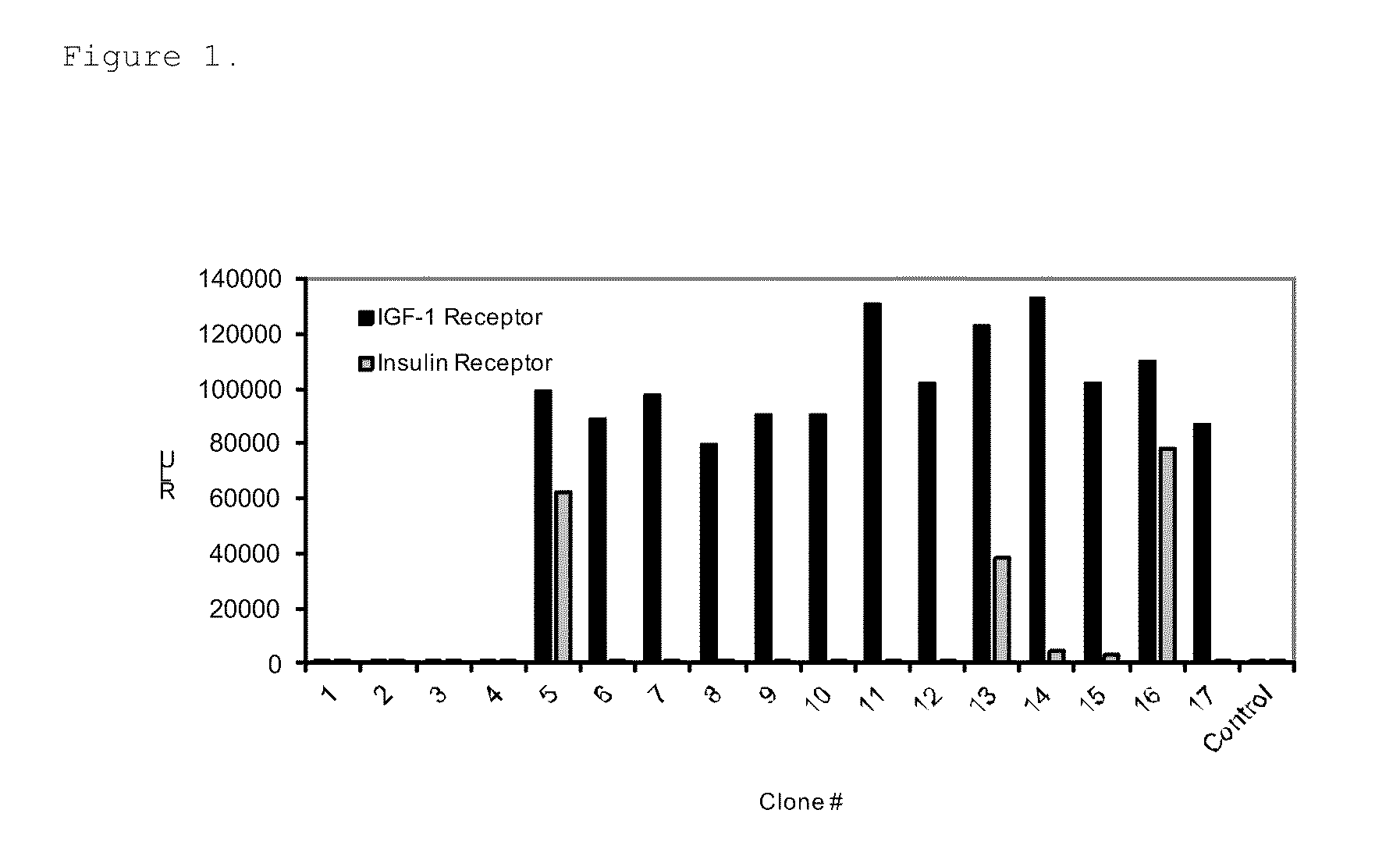Insulin-like growth factor 1 receptor binding peptides
- Summary
- Abstract
- Description
- Claims
- Application Information
AI Technical Summary
Problems solved by technology
Method used
Image
Examples
example 1
Identification of IGF1R Binding Peptides
Phage Panning
[0062]The pIX phage libraries displaying random peptides were generated according to methods described in US Pat. Appl. No. US2010 / 0021477, and used as a source of human IGF1R binding peptides. This library was panned in solution against a biotinylated form of purified soluble IGF1R (sIGF1R) having a carboxy-terminal hexahistidine tag (R&D Systems, Minneapolis, Minn.) for three rounds. Biotinylation of sIGF1R was done using the EZ-Link No-Weigh Sulfo-NHS-LC-Biotin Microtubes (Pierce, Rockford, Ill.). Because of the large size of sIGF1R (˜330 kDa), Tetralink Avidin beads were used for round 1 selection due to their ˜10 fold greater binding capacity than Dynal magnetic beads.
[0063]Total of 384 individual phage lysates from the panning were tested for binding specificity towards sIGF1R in a solid phase phage ELISA. Briefly, 100 μl / well of 5 μg / ml sIGF1R (R&D Systems, Minneapolis, Minn.) was bound to Black Maxisorp Plates (Nunc, Roche...
example 2
Characterization of the IGF1R Binding Peptides
[0066]The identified IFG1R binding peptides were cloned in-frame to the C-terminus of the protein G IgG domain (PG) in a modified pET17b vector (EMD Chemicals, Gibbstown, N.J.) having a ligation independent cloning site (LIC) to generate PG-peptide fusions. The IgG binding domain of protein G is stable and thus enabled easy purification of the fusion protein from bacterial lysates. The amino acid sequence of the protein G IgG domain used is shown in SEQ ID NO: 31. The PG-peptide fusions were expressed in bacteria upon 1 mM IPTG induction and purified using IgG Sepharose beads (GE Healthcare Life Sciences, Piscataway, N.J.) from the bacterial lysates cleared by centrifugation at 16,000 g, 4° C. for 20 min.
[0067]Relative binding affinities of the PG-peptide fusions for sIGF1R were measured using ELISA. The Kds were determined using GraphPad Prism 4 software with a one site binding equation. 100 μl of 2 μg / ml sIGF1R(R&D Systems, Minneapolis...
example 3
In Vitro BBB Model
[0070]Select sIGF1R binding peptides were further characterized in the in vitro blood-brain barrier model, rat brain microvascular endothelial cell model.
[0071]Rat Brain capillary endothelial cells were prepared as described (Perriere et al., J. Neurochem. 93:279-289, 2005). Briefly, brains from 6-8 week old male Sprague Dawley rats were rolled on 3 MM chromatography paper to remove the meniges, cut sagitally, and the white matter dissected leaving the cortices, which were then minced thoroughly. The minced cortices were transferred to a 50 ml polypropylene conical tube with 20 ml DMEM supplemented with 39 units / ml DNase I (Worthington, Lakewood, N.J.) and 0.7 mg / ml Collagenase type 2 (Worthington, Lakewood, N.J.) at final concentration and incubated at 37° C. with gentle mixing for 1.25 hrs. After a brief centrifugation the resultant pellet was resuspended in 20 ml 20% BSA (Sigma, St. Louis, Mo.) in DMEM, centrifuged and the microvessel enriched pellet was isolate...
PUM
 Login to View More
Login to View More Abstract
Description
Claims
Application Information
 Login to View More
Login to View More - R&D
- Intellectual Property
- Life Sciences
- Materials
- Tech Scout
- Unparalleled Data Quality
- Higher Quality Content
- 60% Fewer Hallucinations
Browse by: Latest US Patents, China's latest patents, Technical Efficacy Thesaurus, Application Domain, Technology Topic, Popular Technical Reports.
© 2025 PatSnap. All rights reserved.Legal|Privacy policy|Modern Slavery Act Transparency Statement|Sitemap|About US| Contact US: help@patsnap.com


